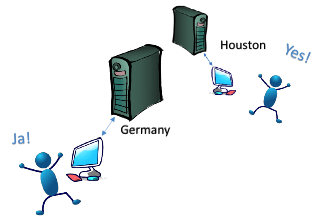Benefits of cmi5
By now you’ve probably heard of cmi5, the successor to SCORM? If not, you might want to check out “Experience API, cmi5 and Future SCORM” in Learning Solutions Magazine. So now you know that cmi5 is a new specification from Advanced Distributed Learning Initiative (ADL), and that cmi5 was co-developed by ADL and the Aviation Industry Computer-Based Training Committee (AICC). With that in mind, let’s take a look at the benefits of cmi5.
cmi5 Benefit 1: It’s based on xAPI
You want to gather as much good xAPI data as you can to perform learning analytics. But you’ve still got that pesky LMS where students take “some” traditional training. How can you get the LMS to write xAPI data? The answer is cmi5. The goal of cmi5 was to address the “use case” where an LMS launches content and gets results. So cmi5 was designed to replace SCORM and it uses xAPI as the communication mechanism between the content and the LMS… so you secretly are getting the xAPI statements you want from traditional learning models. Sweet!
cmi5 Benefit 2: Pop-Up Windows
Raise your hand if you hate pop-up windows. With SCORM, you get a least two windows: One for the LMS and the other for the SCORM content. Usually you get more than two because the SCORM content decides to have its own “player” window.
 If you are an LMS Administrator you probably recognize this phrase from a frustrated user: “The content won’t open.” You know it’s a pop-up blocker. You dread going on the hunt for all the possible pop-up blockers that may be installed on the student’s workstation. Tip from the trenches: I’ve found as many as 7 pop-up blockers on a single machine.
If you are an LMS Administrator you probably recognize this phrase from a frustrated user: “The content won’t open.” You know it’s a pop-up blocker. You dread going on the hunt for all the possible pop-up blockers that may be installed on the student’s workstation. Tip from the trenches: I’ve found as many as 7 pop-up blockers on a single machine.
Even if you clear out all the pop-up blockers, you still get the occasional student that hates pop-up windows… so they just close them immediately, thereby breaking your SCORM module. Finally, if you want to support mobile, pop-ups are a “no-no”.
Fortunately this is addressed in cmi5. Content can now launch in the same window as the LMS. The LMS disappears and the content opens; simple as that. When the content is done, it disappears and the LMS returns, right where you left off.
cmi5 Benefit 3: Distributed Content
Have you noticed that content modules are getting bigger and bigger? As bandwidth has increased, our will to compress and optimize our content seems to have diminished. You know you should, but… surely the bandwidth will handle it, right?
The problem is, if you build a 200 Mbyte content module that works great for your local users, it may not work so well for your remote students. Enter Content Distribution Networks, or CDNs. A CDN allows you to post your web content on several servers, around the country or even around the world. Then, when your student links to the content, they connect to the closest server. A student in Houston might download the content from a Houston-based server, while a student in Germany gets the content from a server housed in Germany.
Just one problem… This won’t work in SCORM. You see SCORM requires that the content and the LMS reside in the same domain. Effectively this means your content must reside on the same server as your LMS, so distributed content is not an option. Sure, some companies have made workarounds for this issue but they are just that… workarounds. They are not interoperable and certainly not “standard”.
 Fortunately, this is one of the benefits of cmi5. Content can reside anywhere, even on a mobile device.
Fortunately, this is one of the benefits of cmi5. Content can reside anywhere, even on a mobile device.
This same issue arises with Content-As-A-Service, or CAAS. If you buy content from an online provider, wouldn’t it be nice if the content could remain on the provider’s site? With cmi5, the CAAS model just works, no workarounds required.
cmi5 Benefit 4: Store any data you want
This is why you are interested in xAPI, right? You can track any performance metric that you want. It’s awesome! But neither the SCORM nor AICC models have this flexibility.
Happily, cmi5 is based on xAPI. So by extension, cmi5 can store any data that is possible in xAPI.
- Store an audio recording of your student responding to a question.
- Store a video of your student performing a task.
- Store an essay written by your student.
cmi5 Benefit 5: Data Sharing
Suppose you have a course that consists of multiple Assignable Units (AU). You need data entered by the student in AU #1 displayed in AU #3. Since the data can be stored in the LRS by AU #1, it is a simple matter to fetch it in AU #3. There’s no way to do this with specifications other than cmi5.
Insist on cmi5
As of this writing, cmi5 has been released as the “Sandstone” version. This is meant as a “beta” period for developers to find issues in the spec. The initial, “Granite” release of cmi5 should be out in the first quarter of 2016. What’s needed now to advance the specification is adoption by content tool developers, rapid authoring tools and LMS vendors. Speak to your vendors and tell them you want cmi5 so you can experience the benefits covered in this article.
